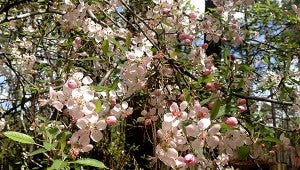Roadside view: Horse sugar, Southern crabapple, and more
Published 9:37 am Wednesday, March 26, 2014

NATURE’S BEAUTY: Southern crabapple’s pale pink blossoms at the Arboretum’s exit gate are a popular subject for photographers.
Photo by Patricia Drackett
Has the past week convinced you that spring has indeed finally sprung after the long winter? Yes, this is the time of year when each passing week features a brand new group of flowering plants taking the stage. With so many new and distinctive blooms popping up along our local roadsides, this is the perfect time for learning some new trees.
Red maple trees are still holding strong. This native species began putting on a color display several weeks ago. Beginning with clusters of scarlet flowers, they are now are loaded with red winged fruit, called samaras. It won’t be long until a windy day or a spring rain will send the samaras crashing to the ground, making a brief but stunning carpet.
At the Arboretum, we find a wide variation in the color of our red maples. Some maples sport bright red fruit, while others are festooned in samaras having more muted tones. Perhaps the color difference is due to some of the maples being the variety called swamp red maple or Drummond’s red maple (Acer rubrum var. drummondii). From this name you may surmise that it is found growing in very wet areas, and it does, such as in cypress-tupelo habitats.
One of the identifying characteristics of the swamp red maples is the delightfully fuzzy, “wooly” undersides of its leaves, a condition called “tomentose”. Children enjoy learning how to tell a red maple from a swamp red maple by rubbing the leaf undersides to see if the fuzz rubs off easily. I’ve seen this tree in swamp forests, often having leaves that are much, much larger than a typical red maple, and having dense “fuzz”.
Another flowering tree you might spot along the roadsides is horse sugar (Symplocos tinctoria), a semi-evergreen small tree also called sweetleaf. One specimen is located across from the Pavilion on the Pond Journey. Search the Web for an image of its attractive (and fragrant!) ivory-white flower with bright orange anthers, giving the blooms the appearance of frilly ballerina tutus.
Southern crabapples (Malus angustifolia) create pale pink flashes along the local roadsides. The tree’s delicate pink blooms make it a highly desirable flowering specimen tree. When in full bloom it is certainly one of those trees that will inspire you to want to plan one. Our beautiful specimen currently glowing at our exit gate has caused many visitors lately to stop their car for photos.
Another tree easy to identify from the car is blooming on the bend in Ridge Road across from the Crosby Arboretum property. Here you will see a gorgeous Eastern redbud (Cercis canadensis). In the East Tennessee of my youth, redbuds mingled with the white and pink-blooming flowering dogwoods along my neighborhood’s “dogwood trail”. It is a tree I equate with spring.
Redbud is a member of the Leguminosae, or pea, family. Look closely at its blossoms and you will see the resemblance to its other family members. The tree prefers moist well-drained sites, is drought tolerant once established, and said to be happy in both acidic and alkaline soils. It also has the amazing ability to fix nitrogen from the air to use as a nutrient.
Although everything I have read about redbud seems to indicate that it is easy to grow, I’ve still managed to kill all the ones I’ve planted. My conclusion is that I’ve provided them with too little water for establishment. It does do well in natural areas, or other places where the tree has decided to “plant itself”, such as in my landscape beds where I don’t want it – such as growing out of the center of a Spiraea bush. But when redbud is thriving, it is a show-stopper. The blossoms are attractive to bees, and many species of birds and wildlife will feast on its seeds.
Join us for a field walk on the Arboretum grounds on Saturday, April 5 at 10 a.m. Ask questions, and learn more about the native wildflowers and other plants blooming this time of year, and how to incorporate them into your home landscape. The program is free to members and $5 for non-members.
For more information or to sign up for a class, call (601) 799-2311. The Arboretum is open Wednesday through Sunday from 9 a.m. to 5 p.m. and located in Picayune, off I-59 Exit 4, at 370 Ridge Road (south of Walmart and adjacent to I-59).
FOR FURTHER EXPLORATION:
Read more about the southern crabapple and horse sugar on the Crosby Arboretum Native Plant Data Base, available on our website’s home page.



